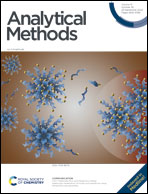Surface-enhanced Raman scattering of a gold core–silver shell-sponge substrate for detection of thiram and diquat
Abstract
Aiming at the difficulty of traditional pesticide sampling, a low-cost and convenient flexible surface enhanced Raman scattering (SERS) gold core–silver shell-sponge (Au–Ag-sponge) substrate was synthesized by chemical reduction. The SERS substrate consisted of Au–AgNPs and a melamine sponge. The sponge had a rich open pore structure, which could well “capture” Au–AgNPs, generating a large number of “hot spots”. The SERS enhancement activity of the flexible substrate was characterized with rhodamine 6G (R6G) Raman probe molecules. The substrate showed good activity to 10−12 M rhodamine 6G with an enhancement factor (EF) of 7.72 × 106. Applying this substrate to the qualitative and quantitative detection of pesticide residues, the results showed that the Raman intensity was well related to the concentration of pesticide solution with the range of 0.1–10 mg L−1 of thiram and 1–10 mg L−1 of diquat. Furthermore, the substrate was analyzed by finite difference time domain (FDTD) simulation and the results were in good agreement with the experimental results. The reason for the difference in Raman signals of pesticide molecules on the same substrate was the different binding modes of Au–AgNPs on the sponge. Finally, we pointed out the advantages of flexible substrates in the field of pesticide residues, as well as future opportunities and challenges.



 Please wait while we load your content...
Please wait while we load your content...